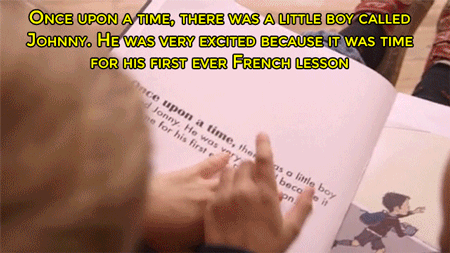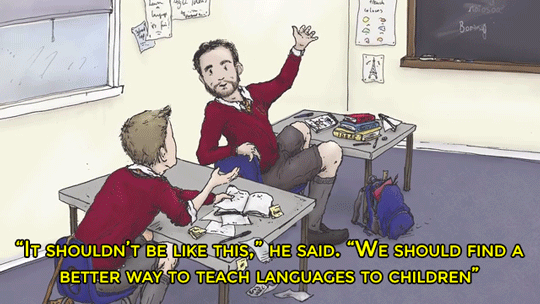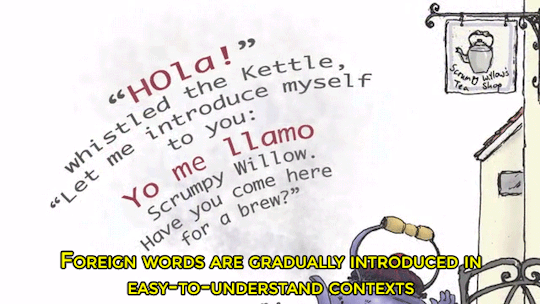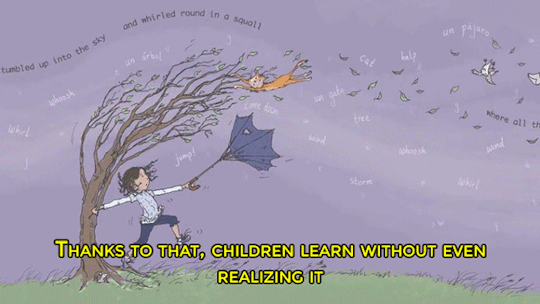Photo




summer days!! Use my code ‘nerhd’ to get 10% off kawaii pen shop!!
488 notes
·
View notes
Video
youtube
We can put whole clauses inside other phrases, but what does that do to their structure and their meaning? In this week’s episode, we take a look at the syntax and semantics of relative clauses: how these clauses kind of look like adjectives; how using them creates islands from which words can’t escape; and how moving things around in them throws semantic variables into the sentence setup.
Looking forward to hearing what everyone has to say! ^_^
31 notes
·
View notes
Photo

Harold Williams a 20th Century Linguist and Journalist spoke 58 languages and learnt Serbian in two days. He amazed delegates at the League of Nations by speaking to each in their own language.
1K notes
·
View notes
Photo
And it's more than proved that audio-lingualism method failed, I don't know how they're teachers who still teach with such method.









Thanks to One Third Stories, kids can learn foreign languages the easiest way possible. Get more information here
161K notes
·
View notes
Photo
Now that I'm studying the B.A. In English Teaching, that's the main problem when it comes to learning languages in public schools, they're still using the audiolinguism method and it's more than proved that it doesn't work...









Thanks to One Third Stories, kids can learn foreign languages the easiest way possible. Get more information here
161K notes
·
View notes
Text
More Forensic Linguistics
Are you interested in discovering more about forensic linguistics? Here are some more ways you can discover more cases featuring forensic linguistics.
Shows:
Forensic Files - Some recommended episodes which showcase it are Letter Perfect, Fate Date, Water Logged, and Writing on the wall.
Text:
Non-Fiction
WordCrime by John Olsson
The C.S.I Effect by Katherine Ramsland
Fiction
Deadly Intent by Kylie Brant
Deadly Advice by Roberta Isleib
Speakers:
Katherine Ramsland:
New Jersey vs. Melanie McGuire case
Forensic linguistics for the National Clearinghouse for Science, Technology and Law
CBC Radio One Show About Linguistic Fingerprints
Robert Leonard:
Forensic Linguistics
Did you enjoy discovering more? Let us know and we’ll post more forensic linguistic cases and more recommendations.
135 notes
·
View notes
Video
youtube
An MRI cross-section of someone’s mouth and throat while singing “If I Only Had a Brain.” According to the description, this is a new MRI technique that scans at the rate of 100 frames per second rather than the typical rate of 10 frames per second, which gives you this really nice and detailed video.
Things to look for: the lips closing for bilabial sounds, such as the /b/ in “brain”, the velum opening for nasal sounds (at the top of the throat, leading into the nasal cavity), such as the /n/ in “brain” (although it actually opens slightly before the /n/, because vowels nasalize before a nasal consonant in English).
212 notes
·
View notes
Photo

Understanding Morphology (2nd Ed.) - Haspelmath & Sims
The download doesn’t seem to be working well, but you can read it straight off of the site.
72 notes
·
View notes
Photo

20 Jul 2017 || ig
Just finished my interpreting exam! Translation - my last exam - will be tomorrow and then I’m ready for my holidays ☀️
621 notes
·
View notes
Text
If someone knows about pedagogy, linguistics blogs, please, let me know. I'm really interested in following blogs about teaching.
0 notes
Photo


18 Dec ‘16
Studying for my physics exam tomorrow!! Pray this gal gets a new lamp and at least a B ✨
44 notes
·
View notes
Text
How do I know if I am fluent?
you don’t
However, I would like to offer some advice to you about exercises you can do to make yourself feel more fluent. Grab some paper or open your laptop’s note application and practice with me ♡
Can you lay down some sick rhymes in your target language? I don’t mean writing your own rap song or a poem (unless you like doing that ofc), but a good way to get your brain flowing and using your target language is to think of some sentences that rhyme! I am trying to do this with my TLs and it is actually grueling but also fun!
Journal it up If you keep a journal, try describing your day or thoughts in your TL. Don’t be afraid to use a dictionary! I find it helpful to learn words I use everyday. It really helps you think without depending on your native language as a crutch.
Counting My career involves a lot of numbers, but I am sure that isn’t so for everyone. However, if you get the chance to count something, try doing it in your TL. If you can’t think of a reason to count, try finding something around you that you see multiple of, and go count it. It may seem ridiculous, but remember that when speaking to a native of your TL, they may throw out some numbers in a situation, and you want to know what they mean!
People-watching or Sightseeing Go sit somewhere and try to describe everything you see using your TL. Write down what you don’t know and look it up when you get home!
Talking to your pet It isn’t always ideal to practice speaking with the people around you, so if you have a pet or live on a farm or something, practice talking out loud in your language with your animals. They won’t laugh at your accent or even understand what you are saying, but there isn’t much anxiety in that situation, and it will help you feel more comfortable speaking around another living being. Plus if you want to work on your accent, it is great.
Translate your work or school related vocabulary into your target language (s) This exercise is actually pretty fun and useful. School and work is v. Important in our lives, so when you are doing light reading, homework, or are slow at work (or are bored at home), look up some words that you use in your everyday situations. This may help if you ever plan on working or going to school in a place where your target language is spoken! For example, if you were suddenly a cashier in France, would you know how to properly greet customers, tell them how much change they are getting back, and understand their responses? You may have to seek out native speakers through a language exchange website (if that is possible for you) for this exercise for the most natural translations.
If you do any of these, post them here on Tumblr to help out the community! I love seeing posts where people share vocabulary, tips, notes, etc.
I am not claiming true fluency for you if you follow my advice, but these will really help. Plus, I took this advice from someone who is bilingual from birth, and who is learning her third language as an adult, so she has lots of experience in this!
2K notes
·
View notes
Note
Hey Alexandra, I saw your Rosh Hashanah OOTD post. I was just wondering if you are Jewish?
Hey! My dad comes from a Jewish family, and my mom comes from a Christian family. They raised my sister and me primarily in the synagogue, but we celebrate both the Jewish and Christian holidays, and I feel as much at home in synagogue as I do at church :) The seamless blending of faith in our household was a really beautiful part of my childhood, and as an adult I’m grateful to have had so much exposure to both belief systems. Because I’m one half my father and one half my mother, I don’t think I could really “choose.” They are both an intrinsic part of who I am and have enriched my life in different ways that are so important to me. I hope that makes sense! :)
6 notes
·
View notes
Photo
@rahaflearns your handwriting is so beautiful, I want to learn Arabic *.*

Me when I tried to learn Arabic
507 notes
·
View notes
Link
As you’re probably aware your essay should start with an introduction which gives the examiner the first impression of your writing skills, in other words it’s vital to know what should and should not be included in this part of the essay.
Academic Writing Part 2- Introduction : Guidelines:
Your introduction has to be clear and concise (2-3 sentences)
Sentence 1-2 – Write a sentence introducing the topic and giving some background facts about it
Sentence 2-3 Write your opinion – only if asked (give your answer/opinion in the introduction and not just the conclusion)
Paraphrase (use synonyms – different words with a similar meaning) and move the order of the sentence around, don’t copy exact words from the topic!
You must not start answering the question in the introduction you write this in the main body.
Avoid “In this essay I will discuss”
Bottom line is: All the information you should include in the introduction is within the topic question you just have to paraphrase it and sometimes include your opinion.
There are 7 types of essay in the writing part 2, so here are 7 examples of the introduction with explanation + additional topic for your own practice.
70 notes
·
View notes
Text
IELTS - Writing
As my IETLS exam is getting so close “16 of May” I decided to post about the exam’s writing section, since it’s one of my weakened areas in English.
First of all, Writing in IELTS is two tasks. The first one is writing about a graph or any given data in figures, tables or line charts etc. You should write 150 words in 20 minutes.
It’s easier than the second task!
Here is some of the phrases and vocabulary that can be used in the first task. They are very helpful and will raise your score.
If you are writing about:
Single Line Graph

How to start:
“The graph shows/reveals/describes … (what, who, when, where). It can be clearly seen that … (describe main trends here).
Vocabulary:
It either rises (increases, climbs, goes up), falls (drops, declines, goes down, decreases), or doesn’t change (remains at the same level, maintains stability).
The highest point of a graph is a peak, and the lowest is a bottom. The speed of change also matters - you should say how fast (rapidly, quickly) or how slowly (gradually, steadily) it happened. and the order of change matters - a rise was preceded by drop and followed by decline.
How to describe Trends:
try to add a little “color” when describing them, because numbers alone are boring. “color” means comparison. write “increased by 155″ or “had risen to 30%” instead of “went from 100 in 1999 to 300 in 2005″.
Double Line Graph

How to start:
“The graph compares … (what, who, when, where). It can be clearly seen that … (describe main trends of 2 graphs here).
Vocabulary:
Same as Single Line Graph.
How to compare Trends:
In the body of the report, describe the first graph in the first paragraph. In the second one, if 2 graphs are similar, start the paragraph with “Similarly” and describe the other graph. If 2 graphs are different, start it with “In contrast” and describe the other graph.
Also compare the peaks and bottoms of the 2 graphs.
Single Bar Graph

Double Bar Graph

How to start:
For single bar graph:
“The graph reveals/shows/describes … (what, who, when, where). It can be clearly seen that … (describe main trends here).
For multiple bar graph:
“The graph compare … (what, who, when, where). It can be clearly seen that … (describe main trends here).
Vocabulary:
The same as for Single Line Graph description.
How to describe or compare trends:
If the axis of the bar graph is a time scale - describe how graph’s subject changes in time.
Otherwise compare the bars differently - more, less, most, least, etc, in order of appearance.
Pie Chart

How to start:
“The pie chart compare … (what, who, where, when). It can be clearly seen that … (describe the most noticeable feature).”
Vocabulary:
When describing a pie chart, write about:
- the highest, significant or lowest percentage.
- the greatest, smallest proportion.
- the lowest number.
- the most, least popular, common item.
How to describe and compare pie charts:
Describe and compare the pieces one by one. If a certain piece is two or three times bigger than another, write “twice (three times) as many Xs were used as Ys”. Another idea is to write “X is much more (considerably less) common than Y”.
Table

How to start:
“The table compares … (what, who, when, where). It can be clearly seen that (describe the most noticeable trend)”.
Vocabulary:
The same as for Single Line Graph description.
How to select and group information:
Describe groups of categories, AKA to divide categories into groups, rather than just throwing the information away. The grouping can be done by similar behaviour.
Process

How to start:
“The flow chart/diagram describes/reveals the procedures of/for …”
Vocabulary:
Explain the sequence of stages/actions and use words like:
-firstly, secondly, thirdly …
- to begin with, then, after that, in addition, otherwise.
- at the same time, concurrently, simultaneously.
- finally.
How to describe a process:
Describe every stage of the process one by one. Use linking words to connect stages from the vocabulary section (above). Mention whether or not there are stages that are being performed at the same time. There may be alternative stages (either stage A or B is performed). The main task here is to describe not to compare or contrast.
it’s better to use present simple passive tense “the letter is written” or “the research is conducted”. Conclusion paragraph is not necessary.
846 notes
·
View notes
